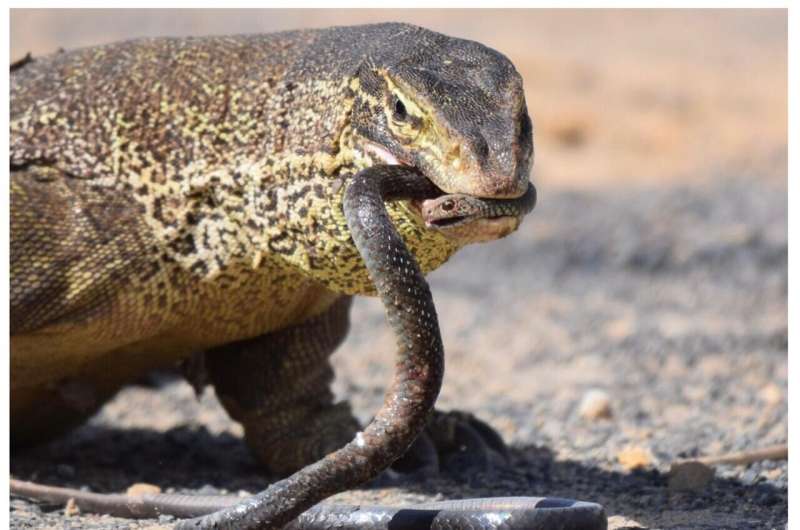This article has been reviewed according to Science X's editorial process and policies. Editors have highlighted the following attributes while ensuring the content's credibility:
fact-checked
peer-reviewed publication
trusted source
proofread
How lizards avoid being killed by venomous snakes

A University of Queensland-led study has shed light on how some lizards have evolved to resist deadly neurotoxins from Australia's most venomous snakes.
The research, led by UQ's Professor Bryan Fry, focused on the interactions between venomous Australian snakes such as death adders, and the varanid lizard species which includes Komodo dragons and goannas. The research paper was published in the International journal of Molecular Sciences.
"Our research found most large varanids or monitor lizards that prey on venomous snakes have inherited neurotoxin resistance—a trait possibly connected to their predatory lifestyle," Professor Fry said.
"To investigate this, we modeled a natural snakebite interaction on varanid lizards by applying venoms to a specific receptor site that we know is targeted by the venom.
"Evolution has equipped these giant lizards with the ability to combat venoms, but not all shield themselves in the same way."
Researchers were also surprised to find two lineages of giant varanids—the Komodo Dragon and the perentie—had reduced chemical resistance to the venom but would use their physical build to armor themselves against the snakes.
"Their thick, bone-filled scales are enough to protect them against snakebite, while their large teeth are used to quickly dismember the fettuccini-like snakes," Professor Fry said.
"This discovery indicates that size and mechanical defenses may reduce the need for chemical resistance—in essence, evolution has favored brawn over biochemistry."
Researchers also found dwarf varanids such as tree monitor lizards lost the chemical resistance as they evolved to live above the ground and away from predators, while other dwarf lineages regained the resistance when they evolved to become burrowers.
Professor Fry said the team collaborated with museums from New South Wales, Northern Territory and Victoria for the research.
"Having direct access to tissue collections was efficient and ethical since it saved us from spending large amounts of time and money to capture animals in the wild."
UQ Ph.D. candidate Uthpala Chandrasekara, who completed the research work as part of her thesis, said the results illustrate the dynamic nature of evolutionary processes in delicate ecosystems.
"This complex dance of adaptation has resulted in a Russian doll-like nesting of gains and losses over time and suggests that the evolutionary battle doesn't always head in one direction," Chandrasekara said.
"Australian snakes have developed potent venoms to counteract the lizards' defenses, highlighting an intense predator-prey dynamic.
"Once the lizards evolve, the snakes fire back with even more potent toxins.
"It's a biological arms race where the only constant is change.
"Moving forward, we plan on looking at related giant lizards in Africa and Asia to expand our insights into these fascinating animals."
More information: Uthpala Chandrasekara et al, A Russian Doll of Resistance: Nested Gains and Losses of Venom Immunity in Varanid Lizards, International Journal of Molecular Sciences (2024). DOI: 10.3390/ijms25052628
Journal information: International Journal of Molecular Sciences
Provided by University of Queensland




















